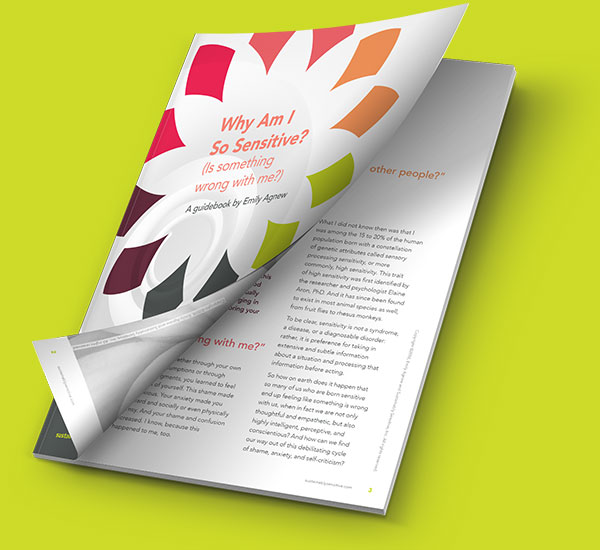As highly sensitive people, we need to cultivate Loving Adult Presence to be able to hold all that goes on in us. Here’s how.
With gratitude to Dr. Elaine Aron for defining them, I’ve often mentioned the four key tasks highly sensitive people need to complete in order to live happy, sustainable lives:
- Learn about the HSP trait
- Reframe your life in terms of the trait
- Heal old trauma
- Hang out with other HSPs
My own work is expressly focused on helping highly sensitive clients make progress with these four key tasks. The first task is deceptively simple. You can Google “HSP” and instantly start taking in information about the trait on the intellectual level.
However, integrating the information emotionally is another thing altogether. This is what we mean by the second task of “reframing:” you begin to process at a deeper level how it was for you to grow up highly sensitive.
In fact, you can’t actually complete the second task without engaging in the third task as well. Only by healing old trauma can you fully reframe your life in terms of your trait. You may find the third task intense. Your inner parts come to the surface, and some of them play rough.
These rough or cruel-sounding parts aren’t trying to hurt you. On the contrary. All your inner parts sprang into existence in an attempt to help you. However, parts are just that—parts. They don’t have the whole picture, or take each other’s needs into account. When parts try to fight things out between them, it never goes well.
Making space for all your inner parts
If you were accepted and celebrated as a sensitive child and taught how to honor your sensitive needs, you may already be approaching your inner world with an accepting, loving attitude. For many HSPs, though, our inner world is a harsh place. It needn’t be. You can learn how to cultivate a more loving inner relationship with yourself.
To complete the tasks of reframing and healing old pain or trauma, you must find a way to make room for all your parts. You need to create a big enough container in yourself to hold “all that,” even (and especially) when it feels overwhelming. That way, you can be the space where there is room for everyone, everyone can be heard, and everyone’s needs matter.
Knowing how to create a big enough container is a key skill for HSPs. As I unpack and describe this skill for you, I do so with a deep bow to Barbara McGavin and Ann Weiser Cornell for Inner Relationship Focusing, which has been life-changing for me and for so many others. In particular, I thank them for the transformative idea that we can be the space in which everything going on in us has a place.
Learning to love yourself
Think about someone in your life about whom you care very much. How do you treat them? I’m guessing you tune in to them. That is, you notice what they are saying, feeling, and needing. You pay attention to them. And you are responsive to what you notice as you tune in and pay attention.
You may recognize this language from the world of attachment theory. This attuned, attentive, responsive way of being is in fact the key characteristic of a loving friend or parent—and of a loving internal parent. You need this “inner parent,” which I call Loving Adult Presence (an amalgam of Self-in-Presence from Inner Relationship Focusing, and the Loving Adult from Inner Bonding) in order to successfully reframe your sensitive life while healing old trauma.
Learning to be a better inner mother and father to yourself is not an overnight fix. It takes time, like building a sturdy new house. Inner Relationship Focusing is a powerful tool for building such a house. I recommend it for all HSPs.
In the meantime, though, how can you begin to create this kind of loving space in yourself, where all your parts can be heard and accepted so that (eventually) they can surrender their “jobs” to you, the adult? Here are three metaphors to help you show up in an attuned, attentive, responsive way with your inner parts.
The photographer
Imagine you are a photographer tasked with taking a picture of a large group. If you are too close to the action—that is, too “merged” with it—you’ll end up leaving out people out of the picture. Only by backing up can you capture the whole thing.
“Backing up” is a key HSP self-care skill. To do it, you simply back up just enough to see and acknowledge everything that is here in you right now. Here’s an example from my oboe auditioning days, before I knew how to “back up:”
The proctor is going to come get me any minute…shit. My mouth is so dry, it’s making the reed stiff. Don’t think about that. Shit! I’m getting self-conscious, I hate this feeling…Don’t think about it! You’re such a head case! Just warm up! My hands are sweaty. My stomach feels really queasy. No matter what I do, this happens.
Ouch. Can you tell that there are several parts in there? There’s a scared one; a harsh one, trying desperately to manage the fear; and one watching the whole thing, feeling incredibly discouraged. There is no adult in sight.
If I had known how to “back up,” I might have said to myself,
I’m noticing my hands are sweaty. My stomach is queasy. There’s a voice saying to stop thinking about all that, and another voice feeling discouraged. Wow. That’s how it is to be me right now. And I am the space where all this can be.
Try this the next time you feel upset or overwhelmed. Picture your feelings and thoughts as a group of people you are attempting to photograph. Then back up enough to include everyone. How much is enough? You’ll know: you’ll feel a release in your body.
The Guest House
In Rumi’s wonderful poem, The Guest House, he writes,
This being human is a guest house.
Every morning a new arrival.
A joy, a depression, a meanness,
some momentary awareness comes
as an unexpected visitor.
Welcome and entertain them all!
Even if they’re a crowd of sorrows,
who violently sweep your house
empty of its furniture,
still, treat each guest honorably.
He may be clearing you out
for some new delight.
When you think of your inner parts as guests rather than intruders, you instantly transform your attitude towards them (thank you, Nina Joy Lawrence and Pat Omidian.) At my audition, for example, I opened the Guest House door and said, “Shit! You again!” Instead, I could have greeted both the queasiness and the “You again!” part as guests.
There is a catch here, though. I need to make sure my welcome is genuine. I have to ask myself, “Am I truly willing and able to welcome this challenging guest?” If I am, great. If I’m not, then I can shift my attention to welcome the one who doesn’t want to welcome the guest.
You can do that all day. Fortunately, though, you’ll find there are rarely more than three layers: the initial feeling, the feeling about that feeling, and a third part looking on in dismay or exhaustion, as the first two go at it out one more time.
The Guest House metaphor reminds us of the truth that all our parts are trying to help us. They may be doing that in ways that are not sustainable, even so, we can’t just tell them to go away. They won’t, until we have a relationship with them. In any case, we wouldn’t want to send them away, because each part contains precious life energy.
The sitting Buddha
Last but not least, to create space in yourself, you can imagine a larger-than-life-sized statue of the sitting Buddha. His vast lap promises more than enough room for anyone who wishes to rest there. When you invoke the calm, the peace, and the inherent inclusiveness of the Buddha’s lap, you point yourself powerfully towards Loving Adult Presence.
The Guest House invokes an attitude of welcome. However, it does require you to do the welcoming. If you don’t feel up to the task, you can turn to the metaphor of the sitting Buddha. Send all your parts to sit on the Buddha’s lap. Then crawl onto it yourself.
Sometimes, perhaps even most of the time, we need spiritual support to change our inner patterns. You don’t have to be a Buddhist to feel the inclusive presence and peace of the sitting Buddha. Once you feel like there is room for you, just as you are, you’ll find it much easier to create room within you for all of your parts.
Photo by Mattia Faloretti on Unsplash



















